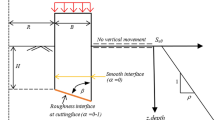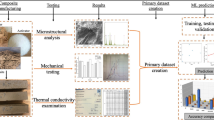Abstract
Initial elastic modulus and compressive strength are the two most important engineering properties for modeling and design of EPS geofoams, which are extensively used in civil engineering applications such as light-fill material embankments, retaining structures, and slope stabilization. Estimating these properties based on geometric and physical parameters is of great importance. In this study, the compressive strength and modulus of elasticity values are obtained by performing 356 unconfined compression tests on EPS geofoam samples with different shapes (cubic or disc), dimensions, loading rates, and density values. Using these test results, the mechanical properties of the specimens are predicted by linear regression and artificial neural network (ANN) methods. Both methods predicted the initial modulus of elasticity (\({E}_{i}\)), 1% strain\({(\sigma }_{1})\), 5% strain \({(\sigma }_{5})\), and 10% strain \({(\sigma }_{10})\) strength values on a satisfactory level with a coefficient of correlation (R2) values of greater than 0.901. The only exception was in prediction of \({\sigma }_{1}\) and \({E}_{i}\) in disc-shaped samples by linear regression method where the R2 value was around 0.558. The results obtained from linear regression and ANN approaches show that ANN slightly outperform linear regression prediction for \({E}_{i}\) and \({\sigma }_{1}\) properties. The outcomes of the two methods are also compared with results of relevant studies, and it is observed that the calculated values are consistent with the results from the literature.





















Similar content being viewed by others
Data availability
Data is available upon request.
Code availability
Code is available upon request.
References
Witthoeft AF, Kim H (2016) Numerical investigation of earth pressure reduction on buried pipes using EPS geofoam compressible inclusions. Geosynth Int 23–4:287–300. https://doi.org/10.1680/jgein.15.00054
Abdelsalam SS, Azzam SA (2016) Reduction of lateral pressures on retaining walls using geofoam inclusion. Geosyn Int 23–6:395–407
İkizler SB, Vekli M, Dogan E, Aytekin M, Kocabas F (2014) Prediction of swelling pressures of expansive soils using soft computing methods. Neural Comput Appl 24:473–485. https://doi.org/10.1007/s.00521-012-1254-1
Özer T (2016) Laboratory study on the use of EPS-block geofoam for embankment widening. Geosynth Int 23–2:71–85. https://doi.org/10.1680/jgein.15.00033
Akay O (2016) Slope stabilization using EPS block geofoam with internal drainage system. Geosyn Int 23–1:9–22
Lyratzakis A, Tsompanakis Y, Psarropoulos PN (2020) Efficient mitigation of high-speed trains induced vibrations of railway embankments using expanded polystyrene blocks. Transp Geotech. https://doi.org/10.1016/j.trgeo.2019.100312
Elragi AF (2000) Selected engineering properties and applications of EPS geofoam. Ph.D. Thesis, State University of New York, USA
Preber T, Bang S, Chung Y, and Cho Y (1994) Behavior of expanded polystyrene blocks. Transportation Research Record
Negussey D (2002) Design parameters for EPS geofoam. Keynote Lecture – IWLGM 2002 International Workshop on Lightweight Geo-Materials. Tokyo, Japan
Abdelrahman GE, Kawabe S, Tatsuoka F, Tsukamoto Y (2008) Rate effects on the stress-strain behaviour of EPS Geofoam. Soils Found 48–4:479–494. https://doi.org/10.3208/sandf.48.479
Duskov M (1997a) EPS as a lightweight sub-base material in pavement structures. Ph.D. Thesis, Delft University of Technology, Netherlands
Duskov M (1997) Materials research on EPS20 and EPS15 under representative conditions in pavement structures. Geotext Geomembr 15(1–3):147–181. https://doi.org/10.1016/S0266-1144(97)00011-3
Anasthas N, Negussey D, Srirajan S (2001) Effect of confining stress on compressive strength of EPS geofoam. In: Proceedings of the 3rd international conference of EPS Geofoam Salt Lake City, Utah, USA. https://doi.org/10.1007/978-3-319-78981-1
Gnip I, Kersultis V, Vaitkus S, Vejelis S (2004) Assessment of strength under compression of expanded polystyrene (EPS) slabs. Mater Sci 10–4:326–329
Athanasopoulos GA, Xenaki VC (2011) Experimental investigation of the mechanical behavior of EPS geofoam under static and dynamic/cyclic loading. In: 4th international conferences on geofoam blocks in construction application. Norway
Birhan AG (2014) Effect of confinement and temperature on the behavior of EPS geofoam. Ph.D. Thesis, Syracuse University, USA
Eriksson L, and Tränk R, (1991) Properties of expanded polystyrene – laboratory experiments. Swedish Geotechnical Institute. Linköping, Sweden
Atmatzidis DK, Missirlis EG, and Chrysikos DA (2001) An investigation of EPS geofoam behaviour in compression. In: Proceedings of the 3rd international conference of EPS Geofoam. Salt Lake City, Utah, USA
Hazerika H (2006) Stress-strain modeling of EPS geofoam for large-strain applications. Geotext Geomembr 24:79–90. https://doi.org/10.1016/j.geotexmem.2005.11.003
Negussey D (2007) Design parameters of EPS geofoam. Soils Found Jpn Geotech Soc 47–1:161–170. https://doi.org/10.3208/sandf.47.161
Elragi AF (2001) Sample size effects on the behavior of EPS geofoam. Soft Ground Technology Conference. Noordwijkerhout, the Netherlands
Srirajan S, Negussey D, Anasthas N, (2001) Creep behavior of EPS geofoam. In: Proceedings of the third international conference on EPS—EPS Geofoam. Salt Lake City, USA
Sun MC (1997) Engineering behavior of expanded polystyrene geofoam and lateral pressure reduction in substructures. MSc. Thesis. Syracuse University, USA
Neto JOA, Rodrigues D (2021) Instrumented load tests and layered elastic theory analysis of a large scale EPS block embankment. Transp Geotech. https://doi.org/10.1016/j.trgeo.2020.100442
Magnan JP, Serratrice JF (1989) Propriétés mécaniques du polystyréne expanse pour ses applications en remblai routier. Bull Liaison Lab Ponts et Chaussées 164:25–31
Horvath JS (1995) Geofoam Geosynthetic: a Monograph. Horvath Engineering. Scarsdale, USA
Liu C (2015) Stress-strain behavior by image analysis, mix density and pre-strain effects of EPS geofoam. MSc Thesis, Syracuse University, USA
Kake D, Kassahun E and Negussey D (2019) The influence of strain rate on EPS geofoam's stress strain behaviour. In: 5th International conference on geofoam blocks in construction applications, Turkish Republic of Northern Cyprus. 161–169
Beju YZ, Mandal JN (2016) Compression creep test on expanded polystyrene (EPS) geofoam. Int J Geotech Eng. https://doi.org/10.1080/19386362.2016.1155260
Malai A, Youwai S (2021) Stiffness of expanded polystyrene foam for different stress states. Int J Geosyn Ground Eng 7:80. https://doi.org/10.1007/s40891-021-00321-7
SohrabVeiseh., Yousefi, A., A., (2021) Compressive behavior and thermal conductivity-density correlation of expanded polystyrene themal insulators. Iran Polym J 30:849–854. https://doi.org/10.1007/s13726-021-00937-6
Zouzias D, Bruyne GD, Miralbes R, Ivens J (2020) Characterization of the tensile behavior of expanded polystyrene foam as a function of density and strain rate. Adv Eng Mater 2:1–13. https://doi.org/10.1002/adem.202000794
Vilau C, Dudescu MC (2020) Investigation of mechanical behavior of expanded polystyrene under compressive and bending loadings. Mater Plast 57(2):199–207
EN14933 (2007) Thermal insulation and light weight fill products for civil engineering applications - factory made products of expanded polystyrene (EPS) – Specification
Norwegian Public Road Administration Publication no.100: Lightweight filling materials for road construction (2002). Oslo
ASTM D1621–10 (2010) Standard Test method for compressive properties of rigid cellular plastics. ASTM International, West Conshohocken, PA, USA
Chun BS, Lim HS, Sagong M, Kim K (2004) Development of a hyperbolic constitutive model for expanded polystyrene (EPS) geofoam under triaxial compression tests. Geotext Geomembr 22:223–237. https://doi.org/10.1016/j.geotexmem.2004.03.005
Leo CJ, Kumruzzaman M, Wong H, Yin JH (2008) Behavior of EPS geofoam in true triaxial compression tests. Geotext Geomembr 26:175–180. https://doi.org/10.1016/j.geotexmem.2007.10.005
Ossa A, Romo MP (2012) Confining stress influence on EPS water absorption capability. Geotext Geomembr 35:132–137. https://doi.org/10.1016/j.geotexmem.2012.03.003
NCHRP Web Document 65 (2004) Geofoam Applications in the Design and Construction of Highway Embankments
ASTM D 6817–11, (2011). Standard specification for rigid, cellular polystyrene geofoam. ASTM International, West Conshohocken, PA, USA
Van Dorp T (1988) Expanded polystyrene foam as light fill and foundation material in road structures, International Congress on Expanded Polystyrene. Milan, Italy
Sanders RL and Seedhouse RL (1994) The use of polystyrene for embankment construction. Transportation Research Laboratory. Contractor Report 356
Miki G (1996) Ten year history of EPS method in Japan and its future challenges. In: Proceedings of international symposium on EPS construction method. Tokyo, Japan
Yaprak H, Karacı A, Demir I (2013) Prediction of the effect of varying cure conditions and w/c ratio on the compressive strength of concrete using artificial neural networks. Neural Comput Appl 22:133–141. https://doi.org/10.1007/s00521-011-0671-x
Bal L, Buyle-Bodin F (2014) Artificial neural network for predicting creep of concrete. Neural Comput Appl 25:1359–1367. https://doi.org/10.1007/s00521-014-1623-z
Belalia Douma O, Boukhatem B, Ghrici M et al (2017) Prediction of properties of self-compacting concrete containing fly ash using artificial neural network. Neural Comput Appl 28:707–718. https://doi.org/10.1007/s00521-016-2368-7
Azarhoosh AR, Hamedi GH, Fallahi AH (2018) Providing laboratory rutting models for modified asphalt mixes with different waste materials. Periodica Polytech Civil Eng 62(2):308–317. https://doi.org/10.3311/PPci.10684
Adil M, Ullah R, Noor S et al (2020) Effect of number of neurons and layers in an artificial neural network for generalized concrete mix design. Neural Comput Appl. https://doi.org/10.1007/s00521-020-05305-8
Mohammed A, Burhan L, Ghafor K et al (2021) Artificial neural network (ANN), M5P-tree, and regression analyses to predict the early age compression strength of concrete modified with DBC-21 and VK-98 polymers. Neural Comput Appl 33:7851–7873. https://doi.org/10.1007/s00521-020-05525-y
Armaghani DJ, Asteris PG (2021) A comparative study of ANN and ANFIS models for the prediction of cement-based mortar materials compressive strength. Neural Comput Appl 33:4501–4532. https://doi.org/10.1007/s00521-020-05244-4
Rodriguez-Sanchez AE, Plascencia-Mora H (2021) A machine learning approach to estimate the strain energy absorption in expanded polystyrene foams. J Cell Plast. https://doi.org/10.1177/0021955X2211021014
Ahmad A, Ostrowski KA, Maślak M, Farooq F, Mehmood I, Nafees A (2021) Comparative study of supervised machine learning algorithms for predicting the compressive strength of concrete at high temperature. Materials 14(15):4222. https://doi.org/10.3390/ma14154222
Wasim M, Ngo TD, Law D (2021) Durability performance of reinforced waste-based geopolymer foam concrete under exposure to various corrosive environments. Case Stud Constr Mater. https://doi.org/10.1016/j.cscm.2021.e00703
Russel S, Norvig P (2009) Artificial intelligence: a modern approach, 3rd edn. Prentice Hall, Upper Saddle River, NJ, USA
Tabachnick BG, Fidell LS, Ullman JB (2019) Using multivariate statistics (7th ed.), New York: Pearson
Salkind NJ (2016) Statics for people who (think they) hate statistics. (4th ed.), LA, London, New Delhi, Singapore, Washington D.C., Melbourne, SAGE
Hair JF Jr, Anderson RE, Tatham RL and Black WC (1995) Multivariate data analysis (3rd ed.), New York: Macmillan
Zurada JM (1992) Introduction to Artificial Neural Systems. West St. Paul
Nguyen H, Bui XN, Bui HB, Mai NL (2020) A comparative study of artificial neural networks in predicting blast-induced air-blast overpressure at Deo Nai open-pit coal mine. Vietnam Neural Comput Appl 32(8):3939–3955. https://doi.org/10.1007/s00521-018-3717-5
Yaguo L (2017) Individual intelligent method-based fault diagnosis. In: Yaguo Lei (Ed.). Intelligent fault diagnosis and remaining useful life prediction of rotating machinery (pp. 67–174)
Zerguine A (2001) Multilayer perceptron-based DFE with lattice structure. IEEE Trans Neural Netw 12(3):532–545. https://doi.org/10.1109/72.925556
Hanandeh S, Ardah A, Abu-Farsakh M (2020) Using artificial neural network and genetics algorithm to estimate the resilient modulus for stabilized subgrade and propose new empirical formula. Transp Geotech. https://doi.org/10.1016/j.trgeo.2020.100358
Turhan C, Kazanasmaz T, Akkurt GG (2017) Performance indices of soft computing models to predict the heat load of buildings in terms of architectural indicators. J Thermal Eng 3–4:1358–1373
Ruppert D (2004) Statistics and finance: an introduction. Springer, New York, USA
Han J, Kamber M, Pei J (2012) Data mining: concepts and techniques (3rd ed.). Elsevier/Morgan Kaufmann
BASF (1998) Styropor technical information. Ludwigshafen, Germany
ASTM C 578–11 (2011) Standard specification for rigid, cellular polystyrene thermal insulation. ASTM International, West Conshohocken, PA, USA
Funding
Not Applicable.
Author information
Authors and Affiliations
Contributions
EA: Conceptualization, Methodology, Regression analyses, Data curation, Draft preparation, Writing, and Editing. GG: Data curation and Draft preparation. BL: ANN modeling, Writing, Draft preparation, and Editing.
Corresponding author
Ethics declarations
Conflicts of interest
Not applicable.
Consent to participate
Hereby, we as the authors of the article “Predictive Models for Mechanical Properties of Expanded Polystyrene (EPS) Geofoam Using Regression Analysis and Artificial Neural Networks” declare our consent to participate in this research on our free will.
Consent for publication
Hereby, we as the authors of the article “Predictive Models for Mechanical Properties of Expanded Polystyrene (EPS) Geofoam Using Regression Analysis and Artificial Neural Networks” declare our consent to publish this paper in the Journal of Neural Computing and Applications.
Additional information
Publisher's Note
Springer Nature remains neutral with regard to jurisdictional claims in published maps and institutional affiliations.
Rights and permissions
About this article
Cite this article
Akis, E., Guven, G. & Lotfisadigh, B. Predictive models for mechanical properties of expanded polystyrene (EPS) geofoam using regression analysis and artificial neural networks. Neural Comput & Applic 34, 10845–10884 (2022). https://doi.org/10.1007/s00521-022-07014-w
Received:
Accepted:
Published:
Issue Date:
DOI: https://doi.org/10.1007/s00521-022-07014-w




